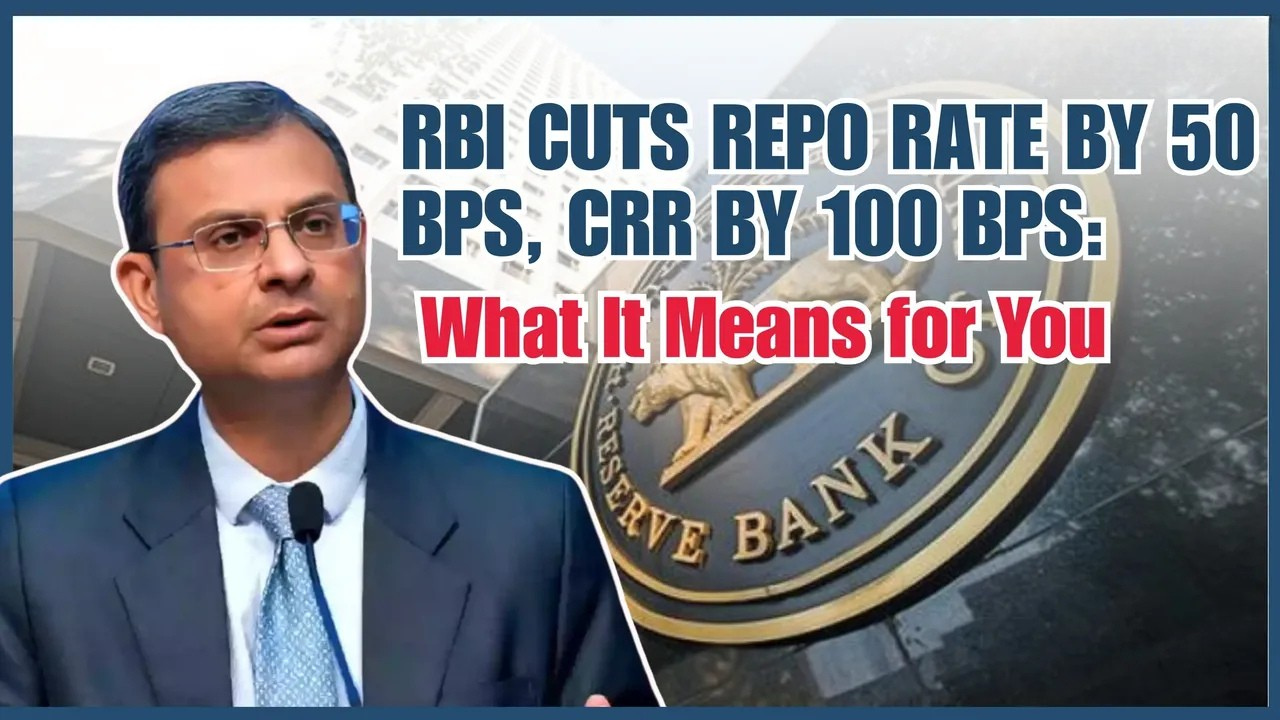- Courses
- GS Full Course 1 Year
- GS Full Course 2 Year
- GS Full Course 3 Year
- GS Full Course Till Selection
- MEP (Mains Enrichment Programme) Data, Facts
- Essay Target – 150+ Marks
- Online Program
- GS Recorded Course
- NCERT- First Ladder
- Polity
- Geography
- Economy
- Ancient, Medieval and Art & Culture AMAC
- Modern India, Post Independence & World History
- Environment
- Governance
- Science & Technology
- International Relations and Internal Security
- Disaster Management
- Ethics
- Current Affairs
- Indian Society and Social Issue
- CSAT
- 5 LAYERED ARJUNA Mentorship
- Public Administration Optional
- ABOUT US
- OUR TOPPERS
- TEST SERIES
- FREE STUDY MATERIAL
- VIDEOS
- CONTACT US
RBI Cuts Repo Rates by 50 bps: Monetary Policy Move
RBI Cuts Repo Rates by 50 bps: Monetary Policy Move

- The Reserve Bank of India (RBI) recently announced a significant monetary policy move in its June 2025 review, reducing the repo rate by 50 basis points (bps) from 6.0% to 5.5%.
- This marks the largest single reduction in recent years, reflecting the RBI’s proactive stance to promote economic growth amidst a challenging global environment.
- Additionally, the RBI cut the Cash Reserve Ratio (CRR) by 100 bps to 3%, injecting approximately ₹2.5 lakh crore into the banking system to boost liquidity.
- The Monetary Policy Committee (MPC) also shifted its policy stance from “accommodative” to “neutral,” indicating a more cautious approach to future rate cuts.
- This refined stance reflects the central bank’s commitment to balancing growth stimulation with a cautious approach to inflation control, based on evolving economic data.
What is RBI’s Monetary Policy Committee and Repo Rate
- Monetary Policy
- It refers to the measures undertaken by the central bank (RBI) to control money supply and interest rates.
- Its primary aims are to achieve price stability, ensure sustainable economic growth, and maintain financial stability.
- Repo Rate:
- It is the interest rate at which the RBI provides short-term loans to commercial banks.
- A reduction in the repo rate lowers the cost of borrowing for banks, which ideally translates into cheaper loans for businesses and consumers, thereby encouraging increased lending and investment across sectors.
- Monetary Policy Committee (MPC):
- Established in 2016, the MPC is a 6-member body responsible for determining the repo rate.
- It comprises 3 RBI officials and 3 external experts.
- The MPC convenes every 2 months to review inflation, GDP growth, and other crucial economic indicators before making policy decisions.
What are the Key Objectives of RBI’s Monetary Policy?
The RBI’s monetary policy operates with specific objectives to maintain economic equilibrium:
- Inflation Control: The primary objective is to target Consumer Price Index (CPI) inflation at 4%, with a permissible tolerance band of 2-6%.
- Growth Stimulation: The RBI adjusts interest rates and other tools to achieve a delicate balance between promoting economic growth and managing inflationary pressures.
- Liquidity Management: The central bank ensures adequate liquidity within the banking system to support healthy credit growth and facilitate economic transactions.
Why Did RBI Cut the Repo Rate by 50 bps Now?
The decision to implement a significant 50 bps repo rate cut in June 2025 was driven by a combination of key economic factors:
- Easing Inflationary Pressures:
- Inflation in India has been on a declining trend, with retail inflation in April 2025 recorded at 3.16%, which is notably below the RBI's target of 4%.
- The RBI has revised its inflation forecast for FY 2025-26 downwards to 3.7% from 4%.
- Global Economic Uncertainties:
- Despite robust domestic growth (GDP growth of 7.4% in Q1 FY 2025-26), the Indian economy faces potential risks from global uncertainties such as ongoing trade tensions, geopolitical instabilities, and slowdowns in major global economies.
- Lower interest rates can act as a buffer, helping to shield the Indian economy from external shocks by stimulating domestic investment and consumption.
- Recent Rate Cuts and Economic Support:
- This 50 bps rate cut is part of a series, following 2 prior cuts of 25 bps each in February and April 2025, bringing the total reduction in 2025 to 100 bps.
- The monetary policy actions are complemented by the Government's fiscal measures, including tax reliefs and infrastructure spending, providing additional stimulus to the economy.
Implications of the 50 bps Repo Rate Cut on the Indian Economy
- Cheaper Loans and EMI Relief:
- The reduced cost of borrowing for commercial banks from the RBI is expected to translate into lower interest rates on loans for both consumers and businesses.
- This will likely lead to cheaper home loans, vehicle loans, and business loans, resulting in a reduction in Equated Monthly Installments (EMIs), providing relief to borrowers.
- Lower EMIs increase disposable income for consumers, which can boost consumer spending and drive aggregate demand.
- Stimulus to Economic Growth:
- With reduced borrowing costs, businesses are incentivized to invest in expansion, capital projects, and new ventures, particularly in interest-sensitive sectors like infrastructure, housing, and manufacturing.
- Consumers are also more likely to make large purchases (e.g., homes, cars), further stimulating economic activity.
- The overarching goal is to increase aggregate demand and support India’s long-term growth trajectory towards 7-8%.
- Increase in Liquidity:
- The 100 bps CRR reduction, alongside the repo rate cut, releases approximately ₹2.5 lakh crore into the banking system.
- This enhanced liquidity ensures that banks have ample funds to extend credit to consumers and businesses, thereby promoting overall credit growth in the economy.
- Increased money supply promotes greater competition among banks, potentially leading to even more affordable loan offerings.
- Impact on Fixed Deposits and Savers:
- Fixed deposit (FD) rates and returns on other traditional savings instruments are likely to decline.
- Savers, particularly senior citizens and conservative investors who rely on fixed-income investments, may experience reduced returns on their deposits.
- This might encourage investors to diversify their portfolios into alternative instruments like mutual funds, bonds, and equities in pursuit of higher returns.
- Inflation and Financial Stability:
- The RBI anticipates inflation to remain within its revised target range of 3.7% for FY 2025-26.
- Despite the push for growth, the RBI has indicated a cautious approach to ensure that the increased liquidity and credit growth do not lead to asset bubbles or an overheating of the economy.
- The shift to a neutral stance underscores the RBI’s commitment to carefully monitor economic data for future policy adjustments.
Ensure IAS Mains Question:Q: The Reserve Bank of India’s decision to cut the repo rate by 50 basis points and reduce the Cash Reserve Ratio (CRR) in June 2025 marks a significant monetary policy shift. Discuss the reasons behind these measures and analyse their expected impact on inflation, liquidity, economic growth, and financial stability in India. (250 words) |
Ensure IAS Prelims MCQ:Q: Which of the following statements about the Reserve Bank of India’s monetary policy tools and concepts is/are correct?
Select the Correct Options: Answer: A Explanation:
|


